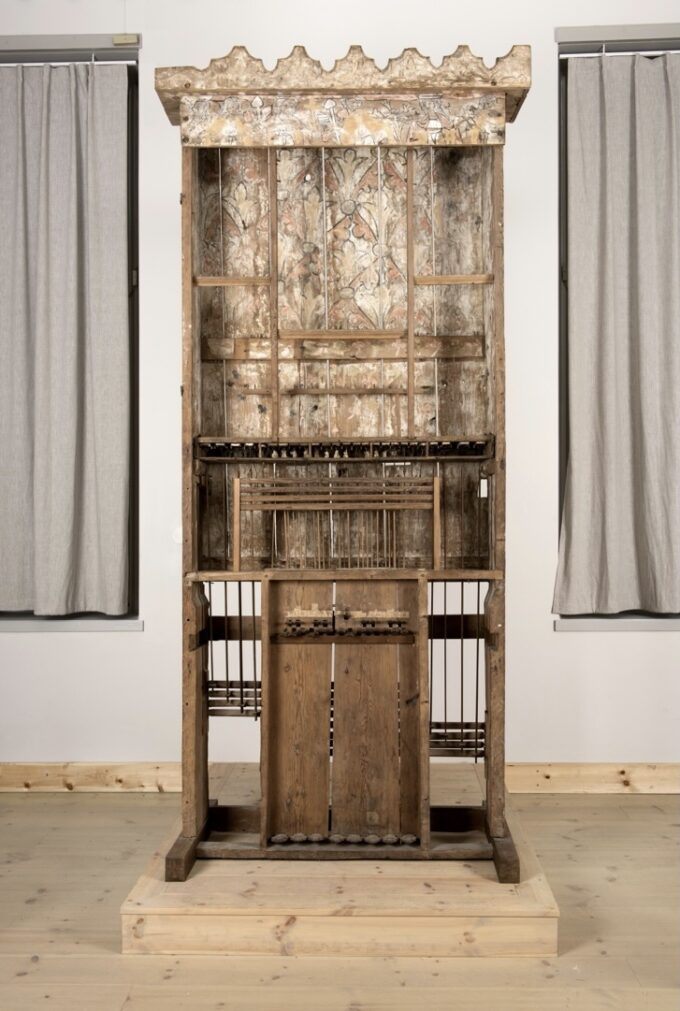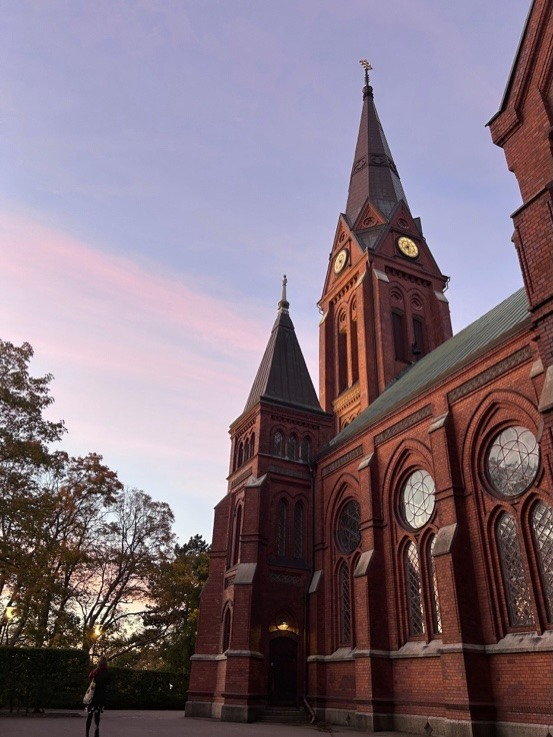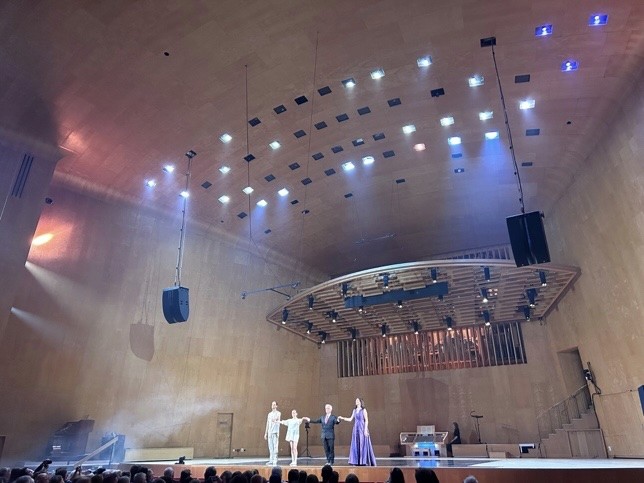
Organ case from Norrlanda, c. 1400. Swedish History Museum, Stockholm. Photo: Ola Myrin.
—Göteborg, Sweden.
The Christianization of Scandinavia took place over a few hundred years and was completed by the early 12th century thanks to Sigurd the Crusader, the Norwegian king who subjugated the intransigent pagans of southern Sweden with cross and broadaxe.
Another useful tool of wonder and pacification was the organ, which eventually came north to promulgate and bolster the new faith. Material testament to the spread of monotheism in Scandinavia can be seen, though no longer heard, in two organ cases, both now in the Swedish History Museum in Stockholm but originally built for churches on the island of Gotland in the Baltic Sea. The more complete of the two comes from the town of Norrlanda and is crowned with crenellated battlements. Contained inside its artfully painted panels are the original mechanics that include the oldest surviving keyboard for the fingers—predating the typewriter by some six hundred years—as well as a row of elegant florets on the floor to be operated by the feet. The Norrlanda organ was not to be played with gauntleted hand or spurred boots but operated unarmed and unarmored. Yet this most advanced technological machine of the pre-industrial world projected a potent Christianized message.
Fly forward—courtesy of EasyJet—to today and the Göteborg International Organ Academy (GIOA) which takes place every year in this harbor city of stately avenues running between Victorian blocks, this ample grid graced by stately parks, intermixed with architecturally bold civic buildings (museums, concert hall, theater, a newer waterfront opera house) and studded with gleaming business and residential towers that stretch towards the sky but have the good sense not to scrape it.
Amongst this varied, yet still happily coherent, urban environment, are many churches—from the baroque to the mid-century modern—and even more organs.
The Swedish State Church was disestablished on January 1, 2000, a forthright recognition that it was time for the Christianity that had reigned for nearly a millennium to cede its dominion and tax dollars to secularism. Two-and-a-half decades on, the Swedes are still a great musical nation: vitally fostered by the church, singing is crucial to the culture. The organ too has retained its role, and no place is prouder then Göteborg of its organ heritage.
The Göteborg Organ Academy was founded in 1994 and the Festival takes place every October, proceeding with vigor, variety and very few pauses. As always, the program’s ten days were packed with morning group lessons for cosmopolitan students from across Europe; concerts in nearby towns; midday recitals on instruments of various vintages and sizes; afternoon seminars that explored the festival theme of “visions” — its open-endedness an invitation to see and hear the past and future in the present; and then recitals late into the night.
Many choirs joined in, in many different ways, as did various ensembles including the magnificent Göteborg Baroque, whose concert toured the Baltic Sea in the war-torn 17th century and into the war-torn 18th. The director, Magnus Kjellson, led his band through this richly reimagined itinerary from a now little-known instrument, the claviorganum: a combination of harpsichord and organ that was not uncommon in the 17th and 18th centuries and has now been recalled into vivid musical action here on the Swedish North Sea coast.
Some places of worship in Göteborg have at least two organs, often of substantial scope. Consecrated in 1890, the “New” Church in the district of Örgryte was built in what was then an empty field on a slope above the city. The suburbs have long since encircled its neo-Gothic walls and tower of redbrick, which now houses two massive organs in two separate balconies: one is a reconstruction of a massive north German instrument from 1699 that once stood in the Cathedral of Lübeck, capital of the Hanseatic League, but was obliterated in World War II; the other at the far end of the church is an almost-as-large English antique of the 19th century rescued from the even more vigorously secularizing United Kingdom.


The North German behemoth was operated by a conclave of international organists on a Friday night concert that proved that the North German Baroque was—and is—as kaleidoscopically colorful as anything digital devices can currently serve up and is easily as persuasive as the weapons wielded by today’s Crusaders of Artificial Intelligence.
The festival’s loudest organ is in the cavernous Vasa Church, a hulking edifice from 1908 whose name conjures thoughts of the extravagant, not to say overweening, Swedish ambition embodied in the ill-fated eponymous warship that sank on its maiden voyage in August of 1628 before it could even get out of Stockholm’s harbor. Both the Vasa Church and its contemporaneous organ glow, but also glower, in their Norse Art Nouveau splendor. The scale and magnificence of the architecture and decoration show no sign of the secularizing revolution that would soon, literally, gather steam. At the time the Vasa Church went up, Christianity was still on the advance and much of the music—not just of a Scandinavian cast, but also English, German, French, and American—heard there in many recitals last week matched the Medieval Monumentalism of its surroundings. Tiny by comparison, the battlements of the Norrlanda organ found their later-Christian counterpart in the twin crosses on the Vasa’s façade. Colossal Romantic works rumbled and echoed, sonically buttressing the neo-Romanesque arches off of which also bounced the occasional spate of more contemporary music. Throughout the festival, but especially in the Vasa Church (which is about a tenth the size of Trump’s Ballroom), it was impossible to fix oneself in time and space. Indeed, the point was not to.


No visible symbols of Christianity were to be seen in the Göteborg Concert Hall from the 1930s, even if sonic ones abounded on its organ— the festival’s largest. Gothic Revivalisms whispered their anachronistic prayers between bouts of contemporary cataclysm. The festival’s last weekend was crowned by a cross-arts extravaganza in that hall that included dance, voice, organ athleticism. Mahlerian world-weariness and Scandic solitude turned their tired faces to the Northern Lights. The bewildered human ballet dancers searched for meaning as the aesthetic and moral compass quivered and spun, illuminated still further at its climax by French virtuoso pyrotechnics. The organ made its case to be at the top of the charts for the End Times.


Adjacent to the Concert Hall is the Art Museum stretching across the top of Göteborg’s biggest public square. In front of the unornamented barrel arches cut into the museum’s flat façade stands a row of naked Classical bronzes on their plinths that look down the main boulevard towards the harbor. If it had been built in fascist Germany or Italy this ensemble would be scary. Actually, it’s pretty scary here too.
In the middle of the piazza stands a fountain with a big bronze statue of Poseidon from 1931. Greened by a lusty patina, the pagan god is naked but for a pointy little sauna hat. He holds a big slick fish that juts out and up from his waistline. This most prominent public art work in Göteborg must count as a harbinger of the Swedish permissiveness, not to say pornography, of the coming secular age.
So nonstop were the musical and musicological doings that one had to go AWOL to discover off-the-organ-piste offerings. An exhibition at the Art Museum lured me in: Apocalypse: From Last Judgement to Climate Threat. The centuries spanned by this engrossing, unnerving show matched the musical times encompassed by the festival. Coincidentally it seemed, organ music ghosted a bleak corner installation through which rode Albrecht Dürer’s Four Horsemen of the Apocalypse. Vesuvius exploded in the Romantic Imagination and onto painterly canvasses; pre- and post-industrial dystopias foretold present and future catastrophes.
Thoughts of escape were quashed by a Nils Olav Bøe’s large format, staged photograph “From Dusk Till Dawn I” which finds a moldering 1960s-style trailer below a light blue sky with a few wispy clouds. There is no sign of that vehicle that brought it to this nowhere and the camper’s tires are deflated. This is the last stop. A clothesline hung with a few garments extends weakly into the wasteland and gives evidence of human activity. But no one is to be seen.


As I hurried from the museum to the next church on the festival program, I recalled that Nero didn’t fiddle as Rome burned and rebellion brewed outside its walls. No, the emperor played the organ. The music of experiment and progress, renewal and faith, heard across the rest of the festival sounded different after the Apocalypse; as the visionary riches swirled around in sacred space, I tried to convince myself that I better understood the lure of religion and the enduring majesty of the King of Instruments.
The post King of the North Sea: The Glories of Göteborg Organ Culture appeared first on CounterPunch.org.
This post was originally published on CounterPunch.org.